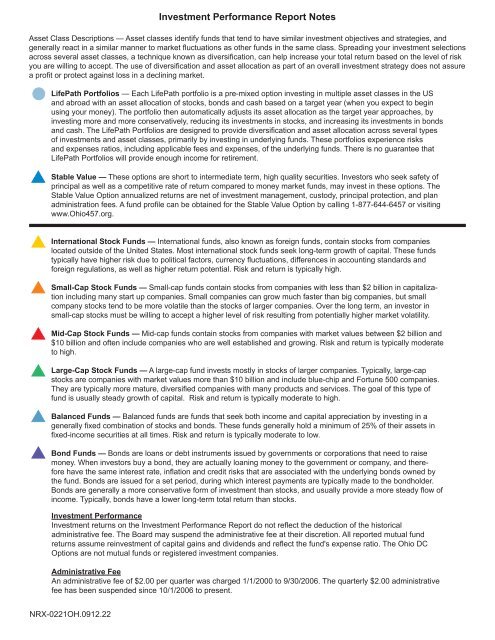Ohio Deferred Compensation Investment Performance Report –– As ...
Ohio Deferred Compensation Investment Performance Report –– As ...
Ohio Deferred Compensation Investment Performance Report –– As ...
Create successful ePaper yourself
Turn your PDF publications into a flip-book with our unique Google optimized e-Paper software.
<strong>Investment</strong> <strong>Performance</strong> <strong>Report</strong> Notes<br />
<strong>As</strong>set Class Descriptions — <strong>As</strong>set classes identify funds that tend to have similar investment objectives and strategies, and<br />
generally react in a similar manner to market fluctuations as other funds in the same class. Spreading your investment selections<br />
across several asset classes, a technique known as diversification, can help increase your total return based on the level of risk<br />
you are willing to accept. The use of diversification and asset allocation as part of an overall investment strategy does not assure<br />
a profit or protect against loss in a declining market.<br />
LifePath Portfolios — Each LifePath portfolio is a pre-mixed option investing in multiple asset classes in the US<br />
and abroad with an asset allocation of stocks, bonds and cash based on a target year (when you expect to begin<br />
using your money). The portfolio then automatically adjusts its asset allocation as the target year approaches, by<br />
investing more and more conservatively, reducing its investments in stocks, and increasing its investments in bonds<br />
and cash. The LifePath Portfolios are designed to provide diversification and asset allocation across several types<br />
of investments and asset classes, primarily by investing in underlying funds. These portfolios experience risks<br />
and expenses ratios, including applicable fees and expenses, of the underlying funds. There is no guarantee that<br />
LifePath Portfolios will provide enough income for retirement.<br />
Stable Value — These options are short to intermediate term, high quality securities. Investors who seek safety of<br />
principal as well as a competitive rate of return compared to money market funds, may invest in these options. The<br />
Stable Value Option annualized returns are net of investment management, custody, principal protection, and plan<br />
administration fees. A fund profile can be obtained for the Stable Value Option by calling 1-877-644-6457 or visiting<br />
www.<strong>Ohio</strong>457.org.<br />
International Stock Funds — International funds, also known as foreign funds, contain stocks from companies<br />
located outside of the United States. Most international stock funds seek long-term growth of capital. These funds<br />
typically have higher risk due to political factors, currency fluctuations, differences in accounting standards and<br />
foreign regulations, as well as higher return potential. Risk and return is typically high.<br />
Small-Cap Stock Funds — Small-cap funds contain stocks from companies with less than $2 billion in capitalization<br />
including many start up companies. Small companies can grow much faster than big companies, but small<br />
company stocks tend to be more volatile than the stocks of larger companies. Over the long term, an investor in<br />
small-cap stocks must be willing to accept a higher level of risk resulting from potentially higher market volatility.<br />
Mid-Cap Stock Funds — Mid-cap funds contain stocks from companies with market values between $2 billion and<br />
$10 billion and often include companies who are well established and growing. Risk and return is typically moderate<br />
to high.<br />
Large-Cap Stock Funds — A large-cap fund invests mostly in stocks of larger companies. Typically, large-cap<br />
stocks are companies with market values more than $10 billion and include blue-chip and Fortune 500 companies.<br />
They are typically more mature, diversified companies with many products and services. The goal of this type of<br />
fund is usually steady growth of capital. Risk and return is typically moderate to high.<br />
Balanced Funds — Balanced funds are funds that seek both income and capital appreciation by investing in a<br />
generally fixed combination of stocks and bonds. These funds generally hold a minimum of 25% of their assets in<br />
fixed-income securities at all times. Risk and return is typically moderate to low.<br />
Bond Funds — Bonds are loans or debt instruments issued by governments or corporations that need to raise<br />
money. When investors buy a bond, they are actually loaning money to the government or company, and therefore<br />
have the same interest rate, inflation and credit risks that are associated with the underlying bonds owned by<br />
the fund. Bonds are issued for a set period, during which interest payments are typically made to the bondholder.<br />
Bonds are generally a more conservative form of investment than stocks, and usually provide a more steady flow of<br />
income. Typically, bonds have a lower long-term total return than stocks.<br />
<strong>Investment</strong> <strong>Performance</strong><br />
<strong>Investment</strong> returns on the <strong>Investment</strong> <strong>Performance</strong> <strong>Report</strong> do not reflect the deduction of the historical<br />
administrative fee. The Board may suspend the administrative fee at their discretion. All reported mutual fund<br />
returns assume reinvestment of capital gains and dividends and reflect the fund's expense ratio. The <strong>Ohio</strong> DC<br />
Options are not mutual funds or registered investment companies.<br />
Administrative Fee<br />
An administrative fee of $2.00 per quarter was charged 1/1/2000 to 9/30/2006. The quarterly $2.00 administrative<br />
fee has been suspended since 10/1/2006 to present.<br />
NRX-0221OH.0912.22



